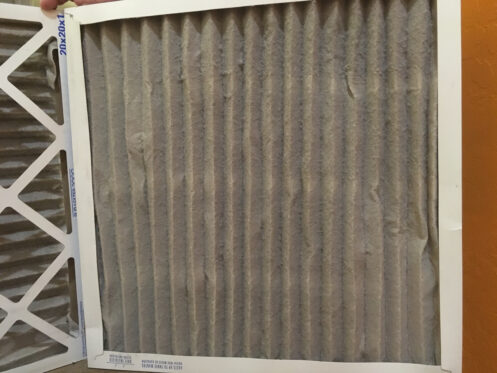Nothing can ruin a summer night like being stuck inside your home while breathing in stale air; this is why it’s so important to make sure you’re doing what you can to improve the quality of your indoor air. With warmer temperatures, more people are spending time indoors, and with that comes an increase in indoor pollutants and allergens. Luckily, there are some strategies you can employ to ensure better indoor air quality for everyone.
1. Clean Air Filters Regularly
Dust and debris can get trapped in your HVAC system’s air filters, reducing their ability to capture airborne pollutants. To ensure that your air is as clean as possible, make sure you’re changing or cleaning your air filter regularly. This will help reduce dust particles and other allergens circulating throughout the home.
The frequency of how often you need to change your air filter depends on the type and size of the filter. Generally, it’s suggested that you change the filter every three months or so, but if you have pets in the house, it may be wise to change them more frequently.
2. Clean and Vacuum Regularly
Keeping up with regular cleaning and vacuuming is essential for maintaining a healthy indoor air environment. Vacuuming with the right vacuum cleaner can help reduce dust, pollen, pet dander, and other allergens from circulating in the air.
When cleaning or vacuuming regularly, ensure you use non-toxic products that won’t emit harmful fumes. Natural cleaners are a great option as they are safer for your health and the environment. When vacuuming, pay attention to areas that don’t get regular attention, such as window sills, behind furniture and curtains. This way, you can get rid of any unseen dust build-up and keep your indoor air clean and fresh.
3. Use Houseplants
Houseplants are not only aesthetically pleasing, but they can also help filter and reduce indoor air pollutants. Certain plants, such as spider plants, dracaenas, and peace lilies, all work to filter formaldehyde from the air, which is commonly found in synthetic building materials.
However, if you have pets at home, it’s best to research which plants are safe for them, as some can be toxic. Additionally, ensure that your houseplants get ample sunlight and water to stay healthy and not release toxins into the air.
4. Ventilate Your Home
Whenever possible, open up windows and ventilation systems so that fresh outdoor air can circulate throughout the home. This will help reduce stagnant air and lower the indoor temperature on hot days, allowing your heating and cooling system to work more efficiently.
However, before you do this, make sure that there are no outdoor allergens or pollutants such as vehicle exhaust, smoke from nearby wildfires, or construction dust that could be making its way into the inside of your home. This way, you can be sure you’re not just exchanging indoor air pollutants for outdoor ones.
5. Use an Air Purifier
Using an air purifier is another great way to improve indoor air quality. An air purifier works by circulating the air in the room and using a filter to capture any pollutants or allergens that may be present. This can help reduce dust and other pollutants from being circulated through your home’s environment.
When choosing an air purifier, select one with a HEPA filter designed to capture even the smallest particles. Additionally, ensure the unit has enough power to cover the size of your space so you can be sure it’s effectively filtering out all of those airborne pollutants.
6. Avoid Strong Fragrances
While many of us focus on temperature control and cleanliness, one factor often goes overlooked: fragrances. Strong perfumes, air fresheners, and candles can release harmful chemicals into the air, exacerbating existing respiratory issues and even causing new ones.
The good news is that plenty of fragrance-free alternatives are available that will keep your home smelling great without risking your health. Look for natural oils or purchase an air purifier with a filter to capture odor-causing molecules. You could also try some natural odor-eliminating techniques, such as boiling cinnamon and orange peels in water. This way, you can keep your home smelling fresh without risking the health of those inside.
7. Make Sure Pets Are Clean and Healthy
If you have pets in the house, you need to ensure they are clean and healthy. Pet fur and dander can carry dust particles and other allergens circulating through the air, reducing indoor air quality.
To reduce this risk, bathe your pets regularly using pet-friendly shampoos and ensure their sleeping area is vacuumed often. Additionally, groom them frequently to remove excess fur from their coats so there’s less of a chance for these particles to become airborne. When grooming, ensure to use a vacuum cleaner designed for pet hair so you can be sure that all those pesky particles are being removed from your home.
8. Monitor Humidity Levels
During the summer months, humidity levels can soar due to increased temperatures and dampness in the air. This heightened humidity has the potential to create an environment that encourages mold growth, which can result in a range of health issues, including allergies and respiratory problems.
Investing in a hygrometer is an easy way to monitor humidity levels and ensure they don’t become too high. If they do, try using a dehumidifier or fans to reduce moisture levels inside your home and keep them at an ideal level. Additionally, use bathroom fans when showering or bathing to reduce excess moisture in the air from steam.
9. Test for Radon
Radon is a colorless, odorless gas that comes naturally from the soil and can seep into your home if there are cracks or openings in the foundation. While it doesn’t cause immediate health effects, long-term radon exposure can increase the risk of developing certain types of cancer.
The best way to protect yourself from radon is to have your home tested. This will allow you to know whether radon levels are high enough inside your home that they could be hazardous to your health. If they are, you may need to invest in a radon mitigation system to reduce the radon in your home.
By following these tips to improve indoor air quality, you can help ensure that your home’s environment is safe and healthy for everyone. From ventilating the home to testing for radon, there are many simple steps you can take to make sure that those inside your home are breathing easy all summer long. If you have any questions or concerns about improving the air quality in your home, reach out to a professional HVAC company for assistance. They can provide more information and advice on keeping the air inside your home clean and healthy.
Contact True Climate Heat + Air for services in heating, cooling, air quality, plumbing and more. Our technicians are committed to providing quality and efficient services for your needs. We serve Oklahoma City and the surrounding areas.


